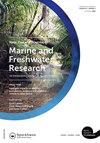Estuaries as coastal reactors: importance of shallow seafloor habitats for primary productivity and nutrient transformation, and impacts of sea level rise
IF 1.7
4区 环境科学与生态学
Q3 FISHERIES
New Zealand Journal of Marine and Freshwater Research
Pub Date : 2022-07-03
DOI:10.1080/00288330.2022.2107027
引用次数: 2
Abstract
ABSTRACT Estuaries are hotspots of primary productivity and nutrient transformation that contribute to food webs and ecosystem functioning locally and in adjacent ecosystems. The depth-dependence of nutrient transformation and primary productivity rates in the water column and the seafloor were investigated, and the lateral transport of solutes and materials across the estuary mouth were quantified. Using an estuary dominated by shallow soft-sediment habitats as a case study, the effects of sea level rise (SLR) on productivity and nutrient transformation processes were projected. The estuary was a net importer of dissolved nutrients from the coast, and a net exporter of suspended sediments and chlorophyll a, supporting the notion that estuaries are important nutrient transformation reactors. A significant depth (and light) effect on productivity indicates that increasing stressors associated with climate change that reduce light at the seafloor (SLR and increased turbidity) will negatively impact estuarine productivity. Intertidal and shallow subtidal benthic habitats were responsible for most of the productivity of the estuary and this is likely to be consistent for other shallow estuaries globally. SLR and anthropogenic intervention that prevents landward migration (i.e. seawalls and armouring), will result in the loss of these habitats and their significant contributions to adjacent coastal ecosystems.河口作为海岸反应器:浅海底生境对初级生产力和营养转化的重要性,以及海平面上升的影响
摘要河口是初级生产力和营养转化的热点,有助于当地和邻近生态系统的食物网和生态系统功能。研究了水柱和海底营养物质转化和初级生产力的深度依赖性,并量化了溶质和物质在河口的横向传输。以浅层软沉积物栖息地为主的河口为例,预测了海平面上升对生产力和养分转化过程的影响。河口是海岸溶解营养物质的净进口国,也是悬浮沉积物和叶绿素a的净出口国,这支持了河口是重要的营养物质转化反应器的观点。深度(和光照)对生产力的显著影响表明,与气候变化相关的压力源增加,减少了海底的光照(SLR和浊度增加),将对河口生产力产生负面影响。潮间带和潮下浅海底栖息地是河口生产力的主要来源,这可能与全球其他浅河口的生产力一致。SLR和阻止向陆地迁移的人为干预(即海堤和护面)将导致这些栖息地的丧失及其对邻近沿海生态系统的重大贡献。
本文章由计算机程序翻译,如有差异,请以英文原文为准。
求助全文
约1分钟内获得全文
求助全文
来源期刊
CiteScore
4.50
自引率
12.50%
发文量
35
审稿时长
3 months
期刊介绍:
Aims: The diversity of aquatic environments in the southern continents and oceans is of worldwide interest to researchers and resource managers in research institutions, museums, and other centres. The New Zealand Journal of Marine and Freshwater Research plays an important role in disseminating information on observational, experimental, theoretical and numerical research on the marine, estuarine and freshwater environments of the region.

 求助内容:
求助内容: 应助结果提醒方式:
应助结果提醒方式:


